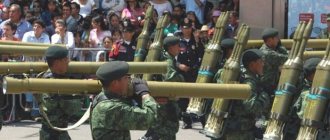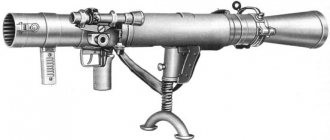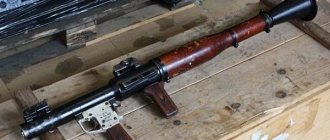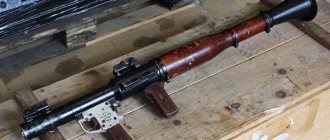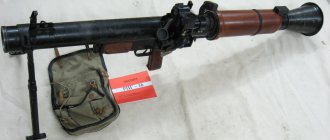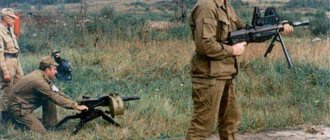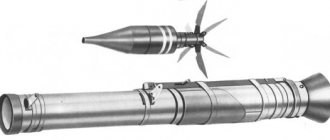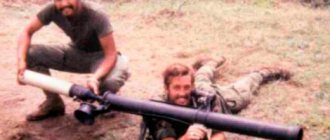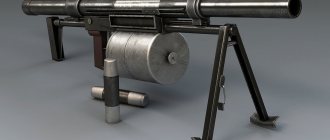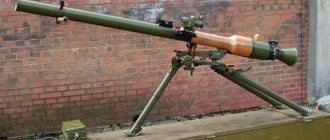The RPG-26 “Aglen” disposable grenade launcher is designed to combat tanks, infantry fighting vehicles, self-propelled artillery units and other armored enemy targets. In addition, a rocket-propelled anti-tank grenade can be used to destroy enemy personnel located in shelters, as well as in urban structures.
Historical reference
widely known both in the Russian Federation and in other world countries as the creator of high-quality and effective weapons. Just look at the legendary RPG-7, created within its walls. And this is far from the only weapon created by the craftsmen of the enterprise.
RPG-26 "Aglen"
Less than a year had passed since the development of the RPG-22 when Basalt began developing a new anti-tank grenade. The creation process lasted two years and already in 1982 the new RPG-26 “Aglen” was presented for preliminary tests, and in 1983-1984 it successfully passed field tests. “Aglen” entered service with the USSR Army in 1985.
RPG-26 "Aglen" and shot (grenade)
This is interesting: the RPG-26 is a single-use individual weapon designed to fight tanks, self-propelled guns and various armored vehicles.
The RPG-26 was developed as an improved version of the Netto grenade launcher, also taking into account the wishes of the military.
RPG-26 "Aglen" front view
The weapon is still in service in over 20 countries around the world. Among them there are countries such as the Russian Federation, Ukraine, etc.
Combat use
In accordance with the standard crew, the RPG-7D must be used by 2 people (the shooter and the shell carrier). Currently, the performance characteristics of the RPG-7 grenade launcher allow it to be actively used by one military personnel. When firing, the grenade launcher should make sure that there are no people behind him.
The development of ammunition makes it possible to use RPGs both against armored vehicles and against fortified enemy positions.
Penetration of concrete shelters can exceed one meter. It should be recognized that modern armored vehicles can withstand many hits from RPGs if outdated ammunition is used.
1961 this year the RPG-7 was developed, the first use was only 7 years later
Developed by 1961, the RPG-7 was first used in combat only 7 years later - during the Vietnam War. The Americans highly appreciated the new weapon; most of the equipment (the same Abrams) could not withstand a direct hit from a Soviet grenade launcher.
The American army, perhaps, fought the most with the enemy using this grenade launcher. Subsequently, the RPG was used in Afghanistan, and Iraq even had a license to produce these weapons. The simplicity of the design makes training grenade launchers quite easy and quick.
Therefore, when conducting battles with an enemy armed with an RPG, it is important to take into account a number of features of this grenade launcher. First of all, the average shot range is 500 m, and for moving objects only 300 m
The projectile explodes upon contact with the surface.
This makes it possible to build up the armor with additional layers.
And in urban battles, it is important for infantry to maintain multiple covers between themselves and the grenade launcher
Since the 1940s, additional layers of “improvised material” have been used against shaped charges - sandbags, barbed wire, etc. This kind of protection should initiate the grenade charge before contacting the immediate surface of the vehicle’s armor.
Although the PG-7VR ammunition is tandem and should neutralize additional layers of protection.
Based on the results of the use of the RPG-7, we can conclude that this firearm is equally effective both in the field, in mountainous areas, and in urban battles. After the shot, the grenade launcher unmasks himself (after the shot, the gun leaves a flash and noticeable gray smoke) and therefore must change position.
Design features, description
Structurally, the new development is practically no different from its predecessor and consists of the following main parts:
- the starting device is a thin-walled fiberglass pipe (analogous to RPG-18 and RPG-22). Designed to fire a grenade and set the direction of its flight + serves as its storage during transportation.
- rocket-propelled anti-tank grenade - a cumulative projectile for hitting a target.
RPG-26 "Aglen".
Design In addition to the main structural components, there are sighting and safety devices, a trigger with a safety pin, a belt and pipe caps. The sight here is also diopter. More detailed information about the design can be found in the material about RPG-22.
RPG-26
The main difference between the new weapon and its predecessor is the ability to transfer it from a combat position to a traveling one. In previous models there was no such opportunity - after transferring to the firing position, you still had to fire (an exception to the rule: if you disassemble the launch tube, then it became possible to return the grenade to the stowed position).
RPG-26 grenade
The time it takes to transfer the grenade launcher from the traveling position to the combat position has been reduced by 2 times, which has increased its effectiveness in combat.
The RPG-26 does not have a barrel extension system (a certain attachment).
RPG-26 "Aglen"
The performance characteristics of the weapon were also slightly improved - the cumulative projectile received greater penetration, and the firing range was increased by increasing the initial speed of the grenade. At the same time, the weapon became slightly heavier.
Device
The tube-tube is closed on both sides with lids, the back of which (the original one) is solid. And in the front cover there is a round hole cut into which the charge is inserted. A belt is attached to special fastenings, which can be adjusted in length.
On the fuse post there is a sight (diopter), the front sight of which has two inscriptions: 50 meters are indicated by the number “5”, and 150 meters - by the number “15”. The trigger mechanism is metal, it is equipped with a pin lock.
Please note that upon purchase you only receive a grenade launcher with instructions for it. Starting devices (TAG sleeves), as well as gas for refilling, will have to be purchased separately.
Shooting process
The Aglen grenade launcher has no recoil when fired. Shooting is done from the shoulder.
Ukrainian soldier with RPG-26
First, you need to turn the front sight all the way up, then remove the pin and unlock the trigger, and then raise the safety post all the way up. After pressing the trigger, the grenade is ejected from the launch tube due to the energy of the combustible powder charge. Next, the fins (stabilizers) are deployed to balance the grenade in flight.
Shooting from RPG-26
Then the grenade flies to the target. When colliding with an obstacle, the fuse is triggered and a cumulative jet is created, which should burn through the armor. In the event of a “non-collision” with the target, the fuse remotely self-destructs.
Principle of operation
First you need to prepare the grenade by loading it with gas. Green gas (or Black gas) is used for this purpose. The charge must first be inserted into the starting sleeve. Now we carefully put all this into the grenade launcher barrel from the front, for which we pull the pin.
As with military weapons, you need to shoot from the shoulder. We move the front sight to the upper position, and raise the safety post until it reaches the stop. This way the grenade launcher will be cocked into combat readiness. Having taken aim, we shoot by pressing the red button. As a result, the valve that releases the gas opens. He pushes the grenade out - it flies out of the barrel, exploding at a distance of more than 100 meters.
Performance characteristics
The table below shows for your reference the main tactical and technical characteristics of the RPG-26 “Aglen”
| Caliber, mm | 72,5 |
| Length, mm | 770 |
| Weight, kg | 2,9 |
| Grenade weight, kg | 1,8 |
| Initial speed of the grenade, m/s | 144 |
| Projectile flight time, s: | |
| at a distance of 50 m | 0,35 |
| at a distance of 100 m | 0,72 |
| at a distance of 250 m | 1,89 |
| Sighting range, m | 250 |
| Direct shot range at a target 2 m high, m | 170 |
| Armor penetration, mm | 440 |
What is RPG 18
It would be wrong to say that the RPG-18 or “Mukha” grenade launcher was the first such weapon in the world. Prototypes of modern grenade launchers were used by German troops during the Second World War. Of course, since that time this weapon has changed a lot, and the functionality has improved (Figure 1).
Figure 1. This is what a grenade launcher and its ammunition looks like
Despite the fact that the principle of operation of the anti-tank grenade launcher is in many ways similar to its German “ancestors,” for the 70s, when the RPG-18 was created, this weapon became a real breakthrough.
The basis was taken from the German idea, slightly improved by the Americans in the M-72 Lowe model. However, Soviet engineers took into account all the features of use and endowed the RPG-18 with the ability to effectively penetrate tank armor. The official name of the RPG is an abbreviation meaning “reactive anti-tank grant”, but in wide circles the model is known as the “Fly” due to the unusual structure of the front sight.
RPG-32 grenade launcher. Dimensions. Weight. Firing range. Caliber
RPG-32 "Barkas" (GRAU index - 6G40) is a Russian reusable hand-held multi-caliber multifunctional grenade launcher. Depending on the type of target, it can be equipped with shots of various calibers from 72.5 to 105 mm, type of warhead and cost. The same trigger for all shots is 36 centimeters long and weighs 3 kilograms, including an optical sight, which is located inside the launcher.
Design
The RPG-7 is a lightweight dynamo-reactive (no recoil when fired) weapon.
The grenade launcher and shot were based on the reusable recoilless launcher and shot with an over-caliber warhead, which had proven themselves in the RPG-2. The grenade launcher consists of a barrel with optical and mechanical sights, a trigger mechanism with a safety catch, and a firing mechanism.
Grenade launcher barrel
The barrel of a grenade launcher consists of a pipe and a pipe and serves to direct the flight of the grenade and remove powder gases when fired. Unlike the RPG-2, the RPG-7 grenade launcher has an extension of the barrel in its middle part - a charging chamber - to more fully utilize the energy of the propellant charge, and a bell in the breech - to ensure recoillessness of the complex.
Trigger mechanism
The trigger mechanism is used to release the hammer, strike the firing pin, and engage the safety.
Sights
PGO-7V1 optical sight reticle - sight scale, 2 - lateral correction scale, 3 - rangefinder scale
Bulgarian soldier with a training (MILES) version of the RPG-7 grenade launcher, equipped with a collimator sight
Mechanical sight
A mechanical sight is used in case of damage (failure) of the optical sight.
Optical sight
The main one for the RPG-7 is the PGO-7 optical sight (or its modifications PGO-7V, PGO-7V-2, PGO-7V-3). The optical sight is designed to monitor the battlefield, determine the distance to the target, introduce corrections for the range and speed of the target, taking into account the ballistics of various ammunition, and point the grenade launcher at the target, taking into account the corrections.
The sight is an optical system of lenses and prisms, enclosed in a sealed metal case filled with dry nitrogen to prevent fogging. The optical sight provides a fixed apparent target magnification of 2.7 times. The sight is equipped with a set of light filters that improve visibility in difficult weather conditions. To prevent unmasking glare from the sun and contamination, the sight is equipped with a rubber cap that fits onto the lens.
The PGO-7V sight reticle has a developed correction scale, as well as a rangefinder scale, which allows you to quickly determine the range to a “tank” type target (2.7 m high). The handwheel provides input of aiming angles in the range of 0-51.2 artillery units, and the aiming mark on the reticle: 0-45.7. In poor lighting conditions, the sight reticle can be illuminated. The backlight lamp uses galvanic batteries A316 or 2РЦ63.
The sight retains its characteristics over a wide temperature range (from −50 to +50 °C), and is also able to withstand high mechanical loads.
Night optical sight
The RPG-7 grenade launcher can be equipped with first-generation night sights (such as the specialized PGN-1 grenade launcher night sight or the NSPUM universal night sight (product 1PN58)) or second-generation NSPU-3 night sights.
For a grenade launcher with a night sight, a light-blocking mechanism is additionally introduced, which prevents the sight from being illuminated by the flame of its own shot.
Universal sighting device
The universal sighting device is a mechanical device weighing 0.55 kg for introducing corrections into the optical sight. It has been used since 2001 in grenade launchers of the RPG-7V2 (RPG-7D3) modifications in conjunction with an optical sight. Allows you to significantly increase the target firing range of thermobaric (TBG-7V) and fragmentation (OG-7V) grenades: up to 550 and 700 meters, respectively.
Other types of sights
Together with the RPG-7, other sighting devices (including homemade ones) are also used: from homemade mechanical sights to replace damaged original ones, to high-tech laser and collimator sights. Most of these devices do not allow corrections for range and target movement, so they are effective only at short ranges.
Ministry of Defense of the Russian Federation - 40-mm hand-held anti-personnel grenade launcher 6G30
6G30 - hand-held revolver 6-round 40 mm grenade launcher.
It is also sometimes called RG-6 or “Gnome” (the latter is the name of the program under which it was developed). Undoubtedly, this is one of the most interesting types of weapons - if only because it combines high firepower with large ammunition and a high rate of fire. December 22, 2022 12:00
The story of its appearance is prosaic, and there is a minimum of romance in it, because the 6G30, like many other types of weapons, is a real “child of war.” It appeared during the period of the most fierce confrontation between federal forces and separatists in the North Caucasus in 1994-1995 as a response to the urgent need of troops for such weapons.
First a beautiful legend. One of the references in the press about the history of the appearance of this type of weapon states that after the well-known events of 1993, during an inspection of the building in the House of Soviets, two South African MGL grenade launchers were found, which were then allegedly copied and the result was our 6G30. There is a conspiracy theory about the “long arm” of the West, which helped those who tried to reshape the order in the country. However, in official reports, in the list of grenade launcher weapons captured in those days, only one RPG-7 is mentioned - apparently, the same one from which they fired at Ostankino and which later became the cause of numerous disputes about who fired and from where.
But how prosaic everything really was with the 6G30. Based on the results of the initial analysis of clashes in urban areas and the general nature of military operations in Chechnya, it became clear that ground troops - both conventional infantry and special forces units - are in dire need of light grenade launchers. The under-barrel GP-25 and the jet RPG-7, which were in service at that time, fulfilled their tasks, but were far from ideal for urban combat. The grenade launcher had ammunition of the required power, but was single-shot, and reloading it took too much time. The RPG-7 was also single-shot, but much more powerful and with one shot it could easily “lay down” an entire floor or burn a tank, but such power was excessive when conducting urban battles. In addition, its use in confined spaces was hampered by a powerful jet stream flying out of the bell at the rear of the tube, which could easily bury both the shooter himself and his entire unit. And a rocket-propelled grenade needed a certain distance to fire - otherwise it would not be armed. What was needed was something with approximately the same power as a standard grenade launcher, but with a higher rate of fire and multiple charges.
6G30 grenade launcher On the Internet and various literature, the 6G30 is sometimes called “Gnome” - this is the name of the R&D program under which the product was created; the abbreviation RG-6 is also found, which can be deciphered as “6-round hand grenade launcher.”
The Tula Central Design Research Bureau of Sporting and Hunting Weapons was entrusted with solving this problem. And not just decide, but in the shortest possible time develop and launch into production a product that would soon go to war. As a result, a little less than six months passed from the start of development to the release of the first pilot batch of 6G30. The task was assigned to the designers V.N. Telesh and B.A. Borzov, who were completely freed from all other projects and were given almost complete carte blanche regarding the resources involved.
In general, no one was required to reinvent the wheel, and the deadlines were not at all conducive to creative delights. All solutions at that time had long been found, and they only needed to be implemented in hardware. There was 40-mm VOG-25 ammunition, used in under-barrel grenade launchers, which suited everyone. But we needed a design that, on the one hand, would allow us to have a loaded ammunition supply of several grenades, and on the other hand, to reload as quickly as possible. And here, too, there were no secrets: at that time, a similar design was developed by several companies, and tested in more than one war. Probably the most prominent representative of this class of weapons was the same MGL produced by the South African arms company Milkor Marketing, allegedly captured in the House of Soviets. The “relationship” of the two samples is visible to the naked eye: they are even similar in appearance, and the general structure is not so different. The reason is banal: the designers had no time to develop a new system - the troops urgently needed weapons. Therefore, Tula gunsmiths simply borrowed the general principle of operation and the very design of the South African grenade launcher, while making certain changes. We’ll talk about the differences a little later, but for now let’s talk about how the 6G30 works.
